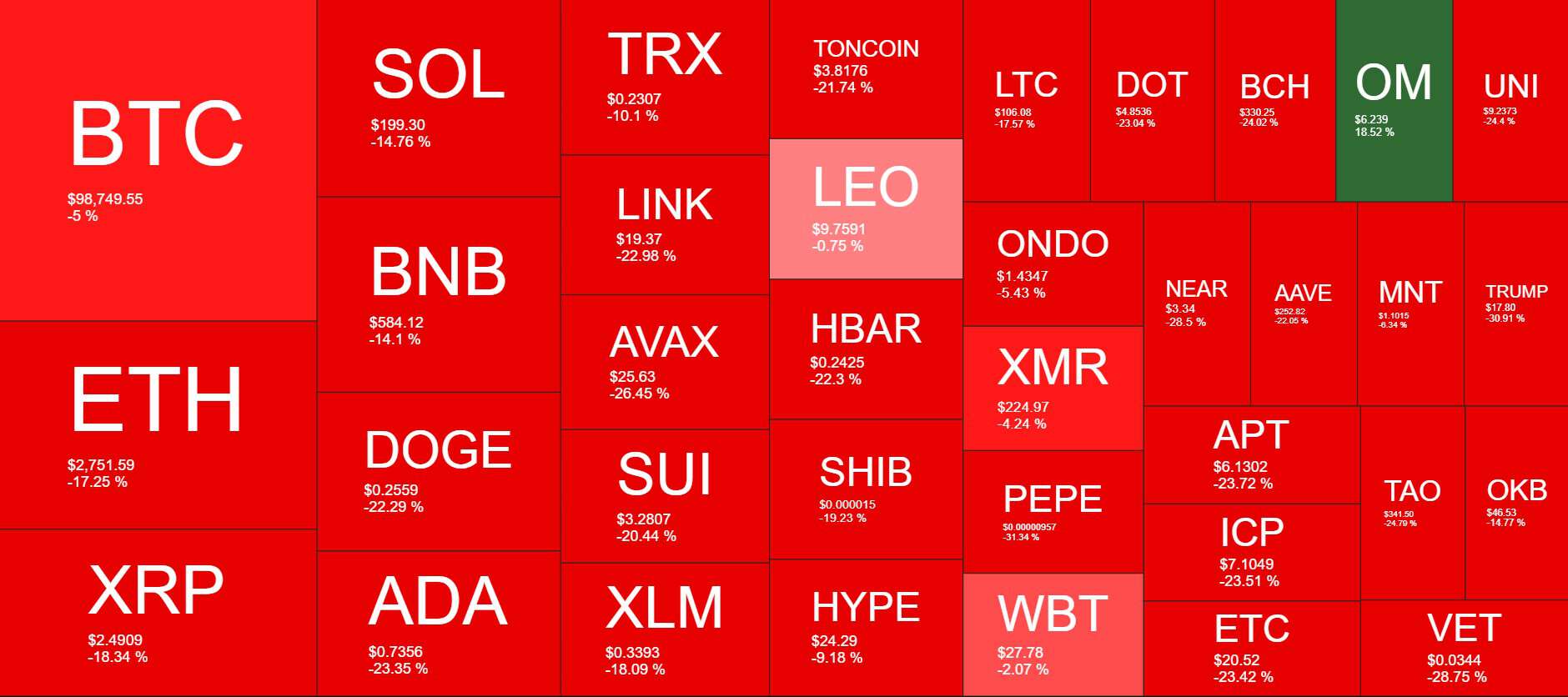1. What is a Crypto Market Crash?

A crypto market crash refers to a rapid and steep decline in the prices of cryptocurrencies, often caused by a combination of external factors such as economic instability, regulatory changes, and market speculation. Unlike traditional financial markets, the crypto market operates 24/7, making it more susceptible to sudden shifts in sentiment and volatility.
2. Key Factors Contributing to the Current Market Downturn

-
Economic Uncertainty and Trade Concerns Economic factors play a significant role in the performance of financial markets, and the cryptocurrency market is no exception. In recent weeks, growing apprehensions about potential trade conflicts and global economic slowdowns have created uncertainty. Concerns over weakening technical structures in traditional financial markets have also led to a more cautious approach among investors. This has contributed to the decline in crypto prices as traders look to reduce risk exposure in uncertain times. As reported by Barrons.com, these macroeconomic factors are making investors wary, leading to decreased demand for digital assets.
-
Market Volatility and Liquidations The crypto market is known for its inherent volatility. As cryptocurrencies such as Bitcoin and Ethereum saw massive gains in recent years, many investors leveraged their positions, hoping to maximize returns. However, when the market started to decline, these leveraged positions were liquidated, driving prices even lower. According to EFileTax.in, this cycle of liquidation exacerbated the downturn and further eroded investor confidence.
-
Regulatory Developments and Fraud Concerns One of the significant factors contributing to the downturn in early February 2025 has been increased regulatory scrutiny surrounding cryptocurrencies. The recent launch of a meme coin by former President Donald Trump, followed by the emergence of over 700 copycat cryptocurrencies, has raised alarm bells regarding potential fraud and market manipulation. The regulatory bodies are now more focused on protecting investors and curbing these deceptive practices. According to TheGuardian.com, these developments have led to heightened concerns among investors, resulting in a wariness that has further fueled the market decline.
3. Impact on Investors
.jpg)
The current market downturn has led to significant losses for many investors, particularly those with large cryptocurrency holdings. For example, those who invested heavily in Bitcoin, Ethereum, or Solana have seen their portfolios erode in value. The market’s rapid price declines and heightened volatility have created a sense of anxiety and uncertainty among traders, with many scrambling to sell off their holdings to minimize losses.
Additionally, retail investors who entered the market during the bull run are now facing substantial financial setbacks. As these investors have often invested based on speculative trends rather than a solid understanding of the underlying assets, they are particularly vulnerable to the current downturn.
4. Strategies for Navigating the Downturn

While the current market conditions are challenging, there are several strategies investors can use to manage risks and protect their portfolios during these volatile times.
-
Diversification One of the most effective strategies for mitigating risk is portfolio diversification. By spreading investments across different asset classes, including both traditional stocks and cryptocurrencies, investors can reduce their exposure to any single market downturn. This strategy helps balance potential losses from the crypto market with gains from other sectors.
-
Stay Informed The crypto market is highly sensitive to news and external developments. Staying informed about regulatory changes, global economic factors, and market sentiment is crucial. Monitoring platforms, news outlets, and updates from trusted sources can help investors make informed decisions in real-time. Being proactive in adjusting investment strategies based on current events can reduce the likelihood of severe losses.
-
Adopt a Long-Term Perspective While short-term market fluctuations are inevitable in the crypto space, adopting a long-term investment strategy can help investors weather periods of market downturns. The cryptocurrency market has historically been known for its cycles of boom and bust, and those who maintain a long-term view are better positioned to benefit from eventual recoveries.
-
Risk Management Investors should also implement solid risk management practices, such as setting stop-loss orders, which automatically sell assets when their prices fall below a certain threshold. This can help limit potential losses during market crashes.
Conclusion
The ongoing downturn in the cryptocurrency market highlights the volatile nature of digital assets. While the declines in the prices of Bitcoin, Ethereum, Solana, and other major cryptocurrencies are unsettling, they are also part of the natural market cycle. Investors need to be aware of the factors driving the current crash, including economic uncertainty, regulatory concerns, and market volatility.
To navigate the challenges posed by this downturn, investors should diversify their portfolios, stay informed about market developments, and adopt a long-term perspective. By following these strategies, investors can better manage the risks associated with the volatile crypto market and be prepared for the potential rebound once the market stabilizes.
Read more:

 English
English Tiếng Việt
Tiếng Việt.png)











.jpg)




